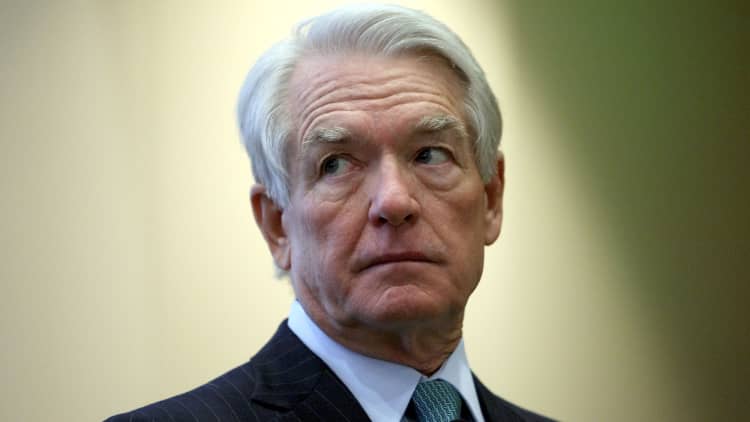The rush by discount brokerage rivals to eliminate all trading fees added Fidelity Investments to the list on Thursday, and it was no surprise. Have you seen the way the discount brokers advertise? Once Charles Schwab, E-Trade Financial and TD Ameritrade had zero trading commissions to tout in their marketing materials, it was inevitable Fidelity would follow.
But the case is not the same in the world of zero-fee exchange traded funds. In the past year a few upstarts have attempted to put a dent in the ETF world by launching funds that charge no fee, or rebate the annual fee, or even pay ETF shareholders to invest. But the experiments from SoFi and Salt Financial have not exactly been a big success.
SoFi's version of the S&P 500 index ETF, SoFi Select 500, which waived the annual fee has attracted a little more than $55 million in assets. Salt Financial's low-volatility equity ETF, Salt Low truBeta U.S. Market, which used the novel approach of offering a "negative" fee — it rebates money to shareholders who invest — until its fund reaches $100 million in assets (the level at which many brokerage platforms are willing to give shelf space to a fund). But it has only taken in $7.7 million, less than Salt's existing ETF, which offered no such fee incentive.
That's amid another gangbuster year for ETF flows, with the total at roughly $200 billion. And tellingly, low fees are the only way to go — just not necessarily all the way to zero.
Of the roughly $80 billion in ETF flows in the third quarter, $57.1 billion went into ETFs that charge 10 basis points (0.10%) or less. Another $16 billion flowed into ETFs charging between 11 and 20 basis points; and $13 billion to ETFs charging 21 to 40 basis points, according to Bloomberg data. Anything above that fee level and the flows were negative.
It was not just SoFi and Salt Financial that discovered there is a limit to how low you can go and find ETF success. J.P. Morgan launched an ETF early this year that provided core U.S. equity exposure at 2 basis points, J.P. Morgan Betabuilders U.S. Equity — lower than the rival Schwab, Vanguard and BlackRock iShares' ETFs. While J.P. Morgan found considerable success with earlier ETFs in its Betabuilders lineup, the U.S. equity ETF has garnered less than $50 million in assets.
"I thought free or rebated products would be more popular than they've been given the investor infatuation with minimal expense ratios," said Todd Rosenbluth, senior director of mutual fund and ETF research at CFRA. "If you screen solely based on expense ratio these products would be at top of the list."
CNBC Evolve will return, this time to Los Angeles, on Nov. 19. Visit cnbcevents.com/evolve to apply to attend.
The reasons behind the humbling start? No. 1: the importance of distribution.
"All of it, ultimately, is evidence of the primacy of distribution in the success equation of ETFs," said Ben Johnson, director of ETF research at Morningstar. Johnson said offering these novel fee structures was a "a good recipe for economizing on marketing spend, but it doesn't look like a recipe for long-term viability."
Investors deserve some credit for doing their homework, said Neena Mishra, head of ETF research at Zacks Investment Research, but the experiences of SoFi and Salt Financial show that marketing tactics do not work unless a company has the distribution platform to support it. The J.P. Morgan lackluster launch is more surprising, given its huge private banking and wealth management platforms. Mishra said that may be the more revealing of the three in terms of how far the envelope on ETF fees can, or even should be, pushed.
The future of the zero-fee ETF
"I don't see a zero-fee or 1 basis point ETF coming from Vanguard or BlackRock, or even J.P. Morgan," she said. "Investors continue to flock to the dominant ETFs. That's what we have seen this year."
The bottom-line truth is that it's hard to launch a successful ETF at any expense ratio. The SoFi and J.P. Morgan ETFs would make the top 10 in assets among all ETF launches in the past year. Only four new ETFs since November 2018 have taken in more than $100 million, and only two have reached the $1 billion mark — iShares ESG MSCI USA Leaders and Xtrackers MSCI USA ESG Leaders Equity — and in these cases the ETFs were seeded with big money from an insurance company.
The biggest winner of all in the move to zero-fee funds was not an ETF offering, but Fidelity Investments, which has now launched four core index mutual funds at no fee, and has raised roughly $6 billion between them, with $4 billion in the U.S. total market fund. That speaks to the importance of controlling distribution, as these funds are only available to Fidelity customers.
SoFi's $55 million in ETF assets "is real money, even if small," Rosenbluth said. "It's always been a tough space and only getting tougher. Distribution is king and we're looking at everything converging at, or near, zero levels, so the fee is increasingly meaningless and distribution more important."
BNY Mellon has filed for a series of "plain vanilla" market-cap weighted index ETFs and it has the needs of clients that custody assets with Pershing to build on. Goldman Sachs is launching core ETFs and it recently acquired model portfolio businesses from S&P and United Capital into which ETFs can be plugged.

Part of Schwab's advantage in the move to zero commissions on products like ETFs is that it has a proprietary lineup of low-cost funds to plug into its popular Schwab Intelligent Portfolios investment platform product. Vanguard, meanwhile, recently filed for a true roboadvisory service at an annual fee of 15 basis points.
Johnson said these early stumbles don't mean that these recent ETF experiments, or the zero-fee ETF concept, is dead.
All the ETF experts said that, for J.P. Morgan, success with low-cost ETFs should continue to come and it is probably only a matter of time given its existing distribution platforms and its investment in a new roboadvisory arm called You Invest.
SoFi said in a statement to CNBC that being the first ETF issuer to offer fee-free ETFs was a way to offer its members a diversified asset at an attainable price point. It was its own worst enemy, though right out of the gates, defaulting investors in its platform into SFY from other core U.S equity exposure and causing tax consequences for those sitting on gains — SoFi has made those investors whole since, agreeing to cover any tax expense, though it was not the headline the company wanted one month after launching the ETF. This tax factor may also explain why J.P. Morgan has been slow to attract assets to a new core U.S. equity fund.
SoFi said ETFs require a long-term view, and it is happy with how the ETF has performed, which is "in line with its goals. "[Assets under management] growth is just one metric we consider as a measure of offering a fund that meets our members' needs," the company wrote in an email.
It is true that SoFi is not an ETF company first and foremost, so if it continues to have distribution platform success, long-term assets may follow. Johnson said the zero-fee concept, once established, will continue to attract notice from some investors. The ETF is the fourth most widely held position on SoFi's platform.
Once you get to levels below 10 basis points, it's splitting hairs. And we've already split those hairs two or three times.Ben Johnsondirector of ETF research at Morningstar
Salt Financial's co-founder, president and chief operating officer Alfred Eskandar said via email, "The negative fee has been very helpful in raising awareness amongst the platform gatekeepers and that has helped us a lot. ... We have emails from advisors who will put money into LSLT once we are approved on their platforms. In the meantime, we continue to receive a steady stream of small retail orders."
Some advisors with strong positioning in distribution can be patient and support these products, Johnson said, and there will be investors interested. "Think about free checking or free content on the internet. When people stop paying for something, they expect they will never have to pay for it again," he said, adding, "there is whole host of less well-capitalized players who will continue to chuck as many fisfuls of pasta at the wall as they can. As an investor, you are the wall and it is important to realize that when you see noodles headed in your direction."
"I don't think they [SoFi and Salt Financial] should regret those decisions, because there has been $200 billion in flows into ETFs this year. ... So why give up the opportunity?" Rosenbluth said. But he added, "I no longer have confidence we will see firms match what SoFi has done because there isn't a track record that says investors want it. Imitation will happen for the right reasons and there is no reason to imitate products still looking to gain scale."
As this applies to broad-based index funds like core U.S. equity, "All I would say is, never say never," Johnson said. "But once you get to levels below 10 basis points, it's splitting hairs. And we've already split those hairs two or three times."
A report from JP Morgan earlier this year showed that the lowest 20% of ETFs by expense ratio captured 80% of U.S. flows in the past five years, while the remaining 80% of funds received just 20% of flows. And the gap is widening, with the lowest fee quintile attracting 97% of all net flows in the past year while the 80% most expensive funds saw close to zero of the $300 billion of new cash invested in U.S. ETFs. But even J.P. Morgan's 2 basis point U.S. equity ETF has struggled to make a dent against 3 basis point and 4 basis point rivals.
"At some point other things matter more than fee differentials," Johnson said.






